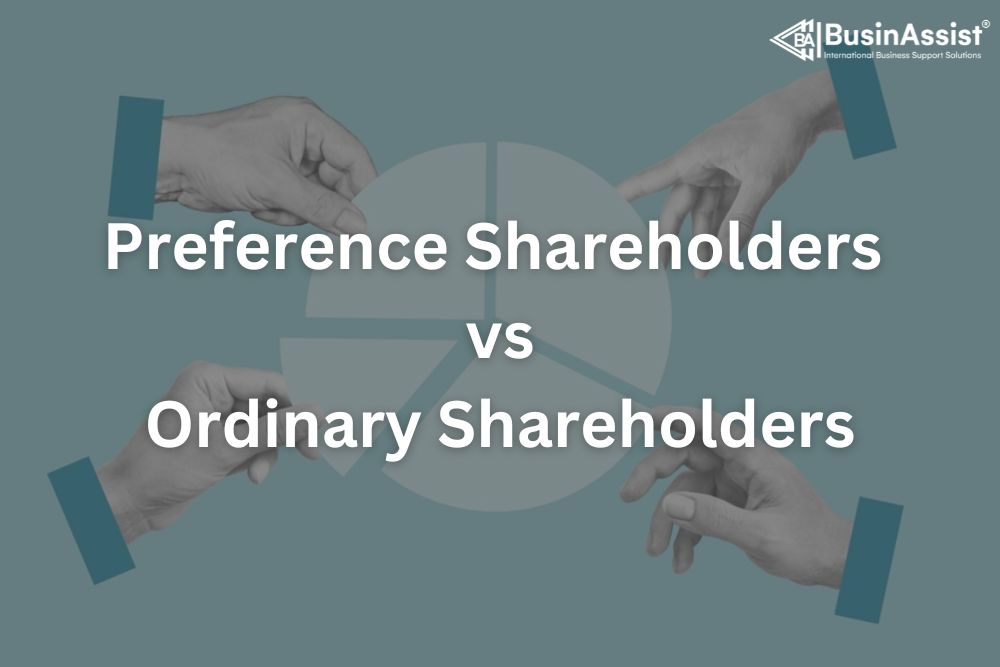Last Updated on December 18, 2025 by Joy Kyalo

Preference Shareholders vs Ordinary Shareholders: Most business owners in the UK incorporate private limited companies which are typically limited by shares. This means that shareholders of a private limited company possess a legal interest in the enterprise and are entitled to receive a portion of the company’s profits.
Limited companies both private and public, issue shares of different classes. Most limited companies are registered with ordinary shares but it is possible to issue more than one class of share. They often introduce preference shares as they grow and need new investments.
This article will highlight the differences between preference shareholders vs ordinary shareholders and who issues them.
What are ordinary shares?

These shares are given when one is incorporating a company. These shares are issued proportionally between the co-founders of the company. They are issued at a nominal value per share which is often £1.
Ordinary shares are traded on securities and money markets, and their price changes according to the market environment, the performance of the company, and how investors feel. These shares are suitable for companies that have one or two shareholders. These shares give shareholders equal rights since they own 50/50 shares. They have equal rights to vote and receive dividends and capital when the company is dissolved.
- Voting rights: Ordinary shareholders are entitled to cast their vote in matters affecting the corporation’s structure e.g. in elections for the Board of Directors and other critical policies.
- Dividends: Ordinary shareholders are entitled to receive dividends, which are a share of the company’s profits allocated to them. However, the amount of dividends paid to ordinary shareholders can vary significantly, as it depends on the company’s financial performance and the dividend policy adopted during each financial year.
- Capital appreciation: Shareholders can also take part in the capital appreciation which happens when the value or price of shares increases with time. Such appreciation enables shareholders to make profits at the times they sell their shares.
- Residual claim: In liquidations, shareholders will receive money after the debts have been paid off.
What are preference shares?

These shares take priority over ordinary shares for dividends and capital payments. However, preference shares have restricted voting rights. Preference shares are almost always fixed-income securities making them not usually participate in the company’s success and are therefore typically a less risky form of investment than ordinary shares.
These priority or preferred rights that attach to the preference shares will be set out in the company’s articles of association. Preference shareholders do not have voting rights unless in exceptional circumstances. They have the following rights:
- Dividends: Preference shareholders receive dividends before common shareholders.
- Capital: If the company goes into liquidation, preference shareholders are paid back from the company’s assets before common shareholders.
- Fixed dividends: Preference shares usually have fixed dividends.
- Voting rights: Preference shareholders usually don’t have voting rights, unless in exceptional circumstances.
Different types of preference shares include:
Non-convertible: Cannot be converted into common shares, but are still prioritised over them.
Convertible preference shares: This type of share permits the holder to convert it into a given number of common shares.
Redeemable: Can be repurchased by the company at a specified price and date.
Non-redeemable: Can only be redeemed by the company when it winds up operations or at the time of liquidation.
Participating preference shares: Such shares give additional earnings beyond the fixed dividend rate to the holder.
Non-participating: Shareholders receive fixed dividends but do not receive additional dividends from the company’s surplus profits.
Cumulative preference shares: In case the firm does not declare a dividend in a particular year, that dividend accumulates and has to be paid before any dividends are paid to non-preference shareholders.
Non-cumulative preference shares: Dividends for these shares are not carried forward to future years if they are not declared in a given year. This means that if the company decides to skip a dividend, preference shareholders cannot claim it later, even when the company resumes dividend payments.
What are the differences between ordinary and preference shares?
Understanding the differences between preference shareholders vs ordinary shareholders is essential for anyone involved in a company’s operations or investments. These two categories of shares represent distinct rights, benefits, and responsibilities for their holders.
Voting rights: Ordinary shareholders have voting rights such as major company decisions and board of directors whereas preference shareholders’ voting rights are restricted.
Dividend rates: There are no fixed dividend rates for ordinary shareholders, unlike the preference shareholders. Preference shareholders’ rates are fixed.
Management role: Ordinary shareholders have a role in the management of the company whereas, preference shareholders do not have a role in the management of the company.
Arrears: Ordinary shareholders do not have a claim over the arrears of their dividends whereas, preference shareholders have a claim over the arrears of their dividends.
Types of shares: Both shareholders have different types of shares.
Preference shares
- Cumulative preference share
- Participating preference share
- Redeemable preference share
- Convertible preference share
- Non-Cumulative preference share
- Non-Participating preference share
- Non-Redeemable preference share
- Non-Convertible preference share
Ordinary shares
- Authorised share capital
- Issued share capital
- Subscribed share capital
- Paid-up share capital
- Right share
- Bonus share
- Sweat equity share
Who issues preference shares?
Business owners issue preference shares if they need to raise capital without giving up any control of the company. These are usually part of the company’s equity financing and are provided to the investors acceptable for both, fixed-income returns and participation in equity appreciation.
Who invests in preference shares?
Some of the investor classes who may consider investing in preference shares include:
- Institutional investors: Most of the institutional investors such as pension funds and insurance companies come in, have preference shares in their pools due to the fact that they bring stable earnings and provide relatively less risk than ordinary shares.
- High net-worth individuals: Wealthy people tend to invest in preference shares, almost any of them, simply as a part of their traditional investment portfolio, owing to the structural benefits of comfort returns through preferred dividends as well as the upside potential from capital appreciation.
- Retirement accounts: Due to their appealing income generation and relatively low-risk perception, preference stocks may be utilized in individual retirement accounts (IRAs) or various other retirement funds.
- Family offices: Affluent families may invest in preference shares to receive predictable returns as well as to protect their assets generating income.
- Corporate investors: Firms may purchase preferred stock in other businesses as part of treasury management or for inclusion into a strategic investment portfolio.
- Hedge funds: These structures in turn may purchase preference shares when investing as part of arbitrage or fixed income characteristics for instance.
- Retail investors: Preference shares may also tempt individual investors who wish to invest in stocks, but are looking for more steady income and less fluctuations than that of ordinary shares.
FAQs
Q: Are preference shareholders owners of the company?
Ans: No, preference shareholders are not owners of the company. However, they are considered partial owners of the company with some rights different from the ordinary shareholders.
Q: Are preference shareholders members of the company?
Ans: No, preference shareholders are not members of the company in the same capacity as ordinary shareholders. They have no ownership interest and voting rights in the company.
Q: Can bonus shares be issued to preference shareholders?
Ans: Yes, a company may issue bonus shares to preference shareholders if it has sufficient accumulated profits. These bonus shares are allocated to shareholders without charge, and there are no legal barriers that prevent preference shareholders from receiving such distributions.
Q: Can preference shareholders attend the AGM?
Ans: Yes, preference shareholders are permitted to attend an Annual General Meeting (AGM). However, they do not have the right to vote or to speak on matters concerning their preference shares.
Q: How to calculate return on ordinary shareholders’ equity?
Ans: The return on ordinary shareholders’ equity (ROE) can be determined using the formula:
ROE= (Net Income/Average Shareholders’ Equity) *100
This calculation, known as return on equity, is calculated by dividing net income by average shareholders’ equity and then multiplying the resulting decimal by 100. The outcome is expressed as a percentage, indicating the profit generated for every dollar invested in equity.
Q: Do all ordinary shareholders have voting rights?
Ans: Yes, ordinary shareholders have voting rights. However, there are some exemptions such as different classes of shares such as “A” and “B” with different voting rights.
Read Also:
- What Business to Start in 2025: Top Business Ideas for Future Success
- Share Capital: Key Advantages and Disadvantages Every Business Owner Should Know
- How to Change Your SIC Code on Companies House: A Step-by-Step Guide for UK Businesses
- Lost Your Government Gateway User ID and Password? Here’s How to Find Them
- A Step-by-Step Guide to Resign as a Director of a Limited Company
- How to Fill Out a Stock Transfer Form J30: A Step-by-Step Guide
- The Hidden Costs of Being VAT Registered: Is It Killing Your Business?
- Important Dates for UK Small Businesses in 2025: Don’t Miss Out!
- What are Redeemable Shares and How Do They Work?
- Revolut vs Monzo: Which Is Right for You?

The BusinAssist Editorial Team has 15+ years of experience writing about small business and company formation in the UK, Canada, and the USA. We simplify complex processes and provide practical insights to help entrepreneurs succeed. Business Assist with BusinAssist – your partner for business success.

